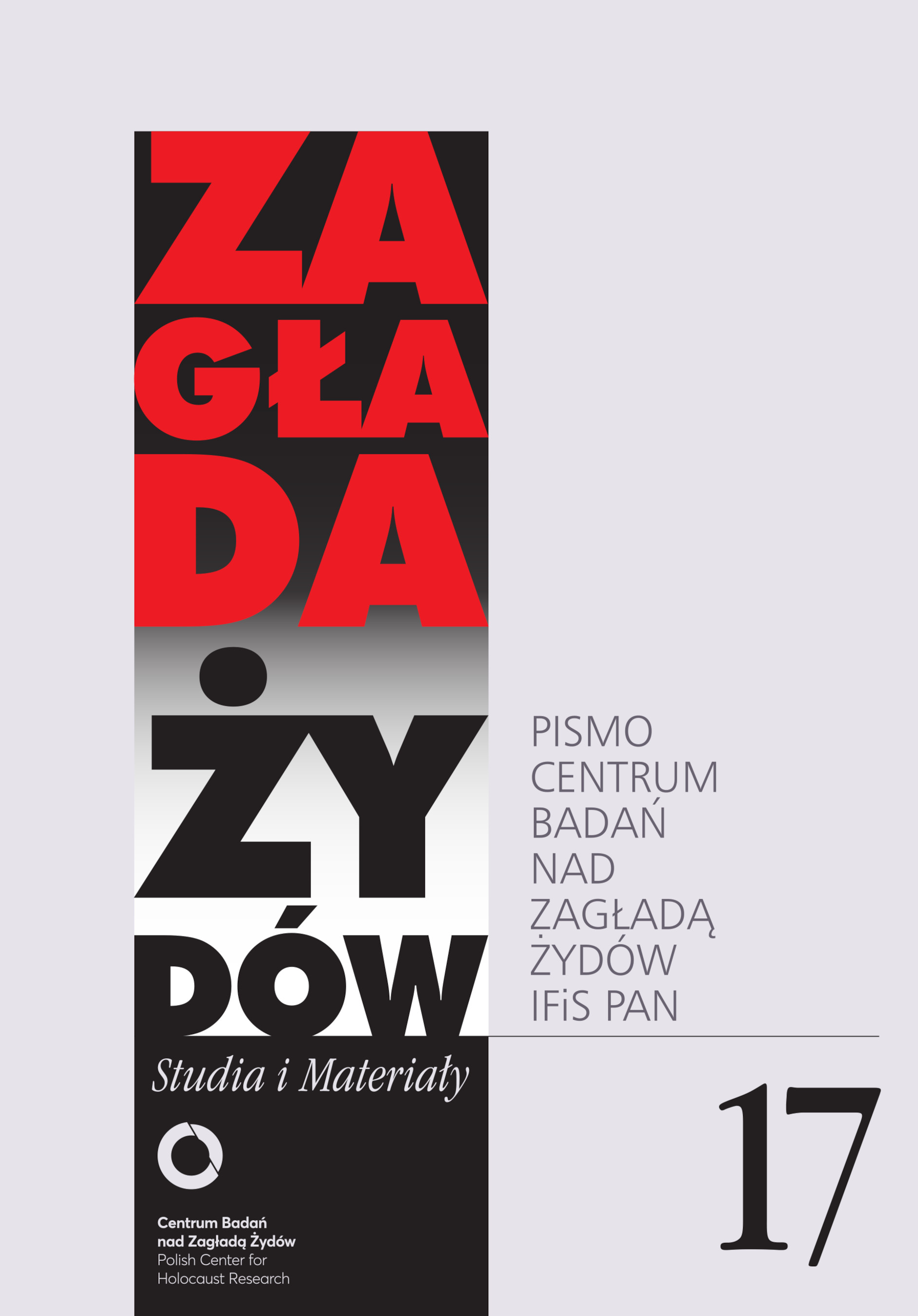“Berek is a voice of powerlessness in the face of cruelty; the desire that the Holocaust would not happen.” Jacek Leociak and Adam Mazur talk to Artur Żmijewski
Zagłada Żydów. Studia i Materiały, No. 17 (2021), Pages: 606-618
Submission Date: 2021-12-19Publication Date: 2021-12-22
 https://doi.org/10.32927/zzsim.897
https://doi.org/10.32927/zzsim.897
Abstract
Adam Mazur: Zanim przejdziemy do „Berka”, chciałbym zapytać, skąd wzięło się u ciebie zainteresowanie historią Zagłady? „Berek” otwiera pewien temat, który będzie w twojej sztuce już stale obecny, ale jest zupełnie niejasne, skąd wzięło się twoje zainteresowanie Zagładą.
Artur Żmijewski: Tak, to nie jest zbyt jasne. Chyba jestem tym „napromieniowany”. Pamiętam, że na studiach zrobiłem pracę, która była inspirowana zdjęciem z albumu Warszawskie Getto. Zdjęcie przedstawiało nagie, ułożone w stos ciała. Na podstawie tego zdjęcia zrobiłem coś w rodzaju rzeźbiarskiego studium aktu – studium martwego ciała i studium przemocy. W sztuce istnieje długa tradycja przedstawiania żywego i martwego ciała.
Wydaje się, że moje zainteresowanie Zagładą pojawiło się razem z boomem wydawniczym lat osiemdziesiątych. Wtedy wydawano wiele wspomnień ocalonych z Holokaustu, ale też zapisków tych, którzy Zagłady nie przetrwali. Dużo tego przeczytałem. Byłem wtedy uczniem I Liceum Ogólnokształcącego na ul. Felińskiego, na Żoliborzu. Profil nauczania, jeśli mogę tak to ująć, był antysemicki. Na moje szczęście byłem fatalnym uczniem, nie czytałem lektur szkolnych, nie odrabiałem lekcji, nie słuchałem nauczycieli. Wagarowałem. I na tych wagarach czytałem własne lektury. I dzięki temu, w tych komunistycznych czasach, „ocalałem prowadzony na rzeź”. A jak już byłem duży, to kupiłem pięciotomową historię obozu Auschwitz i przeczytałem ją od początku do końca. Wpadłem w to, wciągnęło mnie jak bagno, nie umiałem tego zamknąć. To był rodzaj dziwnego oświecenia, wtajemniczenia – rytuał przejścia do prawdziwego świata. Chłonąłem te lektury jak gąbka. Później przyszło opamiętanie – powodowany instynktem samozachowawczym, oddałem całą tę bibliotekę koleżance ...
Keywords
Artur Żmijewski , Berek
License
Copyright (c) 2021 Author&"Holocaust Studies and Materials"

This work is licensed under a Creative Commons Attribution 4.0 International License.
https://creativecommons.org/licenses/by/4.0
The journal is published under the Diamond Open Access Standard, CC-BY-4.0 Deed - Attribution 4.0 International - Creative Commons
Most read articles by the same author(s)
- Jacek Leociak, Marta Tomczok, Affective Holocaust Kitsch – Introduction , Zagłada Żydów. Studia i Materiały: No. 17 (2021)
- Dariusz Libionka, Jacek Leociak, 75th Anniversary of Operation Reinhardt , Zagłada Żydów. Studia i Materiały: No. 13 (2017)
- Jacek Leociak, Understanding the Holocaust. A Task for Generations , Zagłada Żydów. Studia i Materiały: 2008: Holocaust Studies and Materials
- Jacek Leociak, Literature of the Personal Document as a Source in Holocaust Research (a Methodological Reconnaissance) , Zagłada Żydów. Studia i Materiały: No. 1 (2005)
- Jacek Leociak, Literature of the Personal Document as a Source in Holocaust Research (a Methodological Reconnaissance). , Zagłada Żydów. Studia i Materiały: 2008: Holocaust Studies and Materials
- Karolina Sulej, Jacek Leociak, “He Smiled at Me and Sent Kisses with His Hand”. On Dora Sztatman’s testimony , Zagłada Żydów. Studia i Materiały: No. 5 (2009)
- Jacek Leociak, Stanislaw Sreniowski, From a Book of Madness And Atrocity , Zagłada Żydów. Studia i Materiały: No. 1 (2005)
- Jacek Leociak, I don’t want to expose myself to people’s laughter for hiding Jews in my place . . . the case of Zdzisław and Halina Krzyczkowski) , Zagłada Żydów. Studia i Materiały: No. 4 (2008)
- Jacek Leociak, Censorship Keeping Guard over the Church. Krystyna Modrzewska’s Censored Memoir , Zagłada Żydów. Studia i Materiały: 2010: Holocaust Studies and Materials
- Jacek Leociak, On the Abuses in Research of the Holocaust Experience , Zagłada Żydów. Studia i Materiały: 2010: Holocaust Studies and Materials
Similar Articles
- Artur Żmijewski, Photos from Berek , Zagłada Żydów. Studia i Materiały: No. 17 (2021)
- Galit Eilat, The right not to forget , Zagłada Żydów. Studia i Materiały: No. 17 (2021)
- Yisrael, Artur Eisenbach: a Historian and employee of the Jewish Historical Institute , Zagłada Żydów. Studia i Materiały: No. 3 (2007)
- Nawojka Cieślińska-Lobkowicz, Traces of Unknown Pre-war Jewish Collectors and Owners of Works of Art , Zagłada Żydów. Studia i Materiały: No. 17 (2021)
- Jacek Leociak, Anniversaries of the Warsaw Ghetto Uprising in public discourse (with special reference to the years 1943–1944, 1968 and 2023) , Zagłada Żydów. Studia i Materiały: No. 19 (2023)
- Jacek Leociak, Michał Głowinski , Zagłada Żydów. Studia i Materiały: No. 19 (2023)
- Markus Nesselrodt, Who, When, and Why? Escapes of Polish Jews from the Germans to the Soviet Union in the Fall of 1939 and Summer of 1941 from a Comparative Perspective , Zagłada Żydów. Studia i Materiały: No. 18 (2022)
- Krzysztof Rybak, The Holocaust (Not) for Children. Abuses in Polish 21st-Century Children’s Literature , Zagłada Żydów. Studia i Materiały: No. 17 (2021)
- Monika Polit, Artur Kuć, The Apocryphal Text “Josl Rakower’s Testament”. Remarks on Michał Borwicz’s Article , Zagłada Żydów. Studia i Materiały: No. 3 (2007)
- Justyna Koszarska-Szulc, A review: Ewa Koźmińska-Frejlak, Po Zagładzie. Praktyki asymilacyjne ocalałych jako strategie zadomawiania się w Polsce (1944–1950), Warszawa, Żydowski Instytut Historyczny, 2022, 565. , Zagłada Żydów. Studia i Materiały: No. 19 (2023)
You may also start an advanced similarity search for this article.
 English
English
 Język Polski
Język Polski



 https://orcid.org/0000-0003-1471-6926
https://orcid.org/0000-0003-1471-6926

